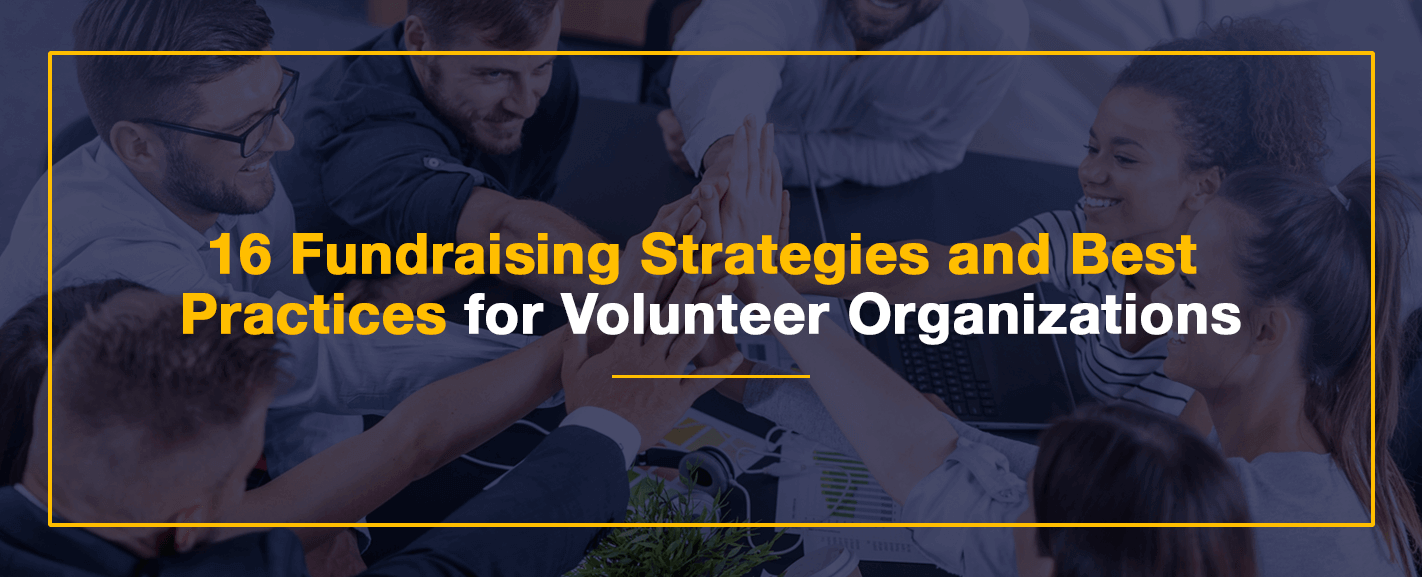It’s a tale as old as time: Nonprofits fundraising from private, individual donors to conduct operations, host events, stabilize operations, and grow.
There are more registered nonprofits today than any other point in history. The vast majority of these organizations name funding as a top challenge, as they seek to grow donor pools and fundraised amounts without making people feel like piggybanks.
Sound familiar? Let’s explore today’s top fundraising tips for volunteer organizations, lending you a set of best practices to add to your fundraising toolkit for fresh fundraising event ideas, team strategies, and approaches.
Top 16 Fundraising Ideas for Volunteer Organizations
There is no “one-size-fits-all” fundraising strategy for every nonprofit organization today. However, there are proven, profitable fundraising tips for nonprofits to sharpen your planning, engage more donors, launch creative fundraising ideas, and — ultimately — increase your financial stability. Here are creative ideas for different types of fundraising you can implement soon.
1. Fundraise For Your Volunteer Initiative
An annual nonprofit fundraising strategy states your nonprofit’s financial priorities for the upcoming year. Alongside those priorities, it will also outline the language behind your case for support, i.e., the fundraising initiatives to donate to your nonprofit, where those donations go, and why that cause is essential.
Understanding your specific fundraising goals and causes for the year is square one to set up intentional, successful fundraising ideas. If you don’t know these reasons yourself, it will be much more of a challenge for you to draft compelling donation pitches or events to raise money.
2. Set up Tiers

Donation tiers are a simple fundraising idea in which your organization selects pre-chosen amounts for current and prospective donors to donate. Nonprofits employ these tiers in place of the traditional, blank donation field on webpages, forms, and more to create a simpler and faster donation portal. Research from Nonprofit Quarterly magazine reveals people tend to donate more money after seeing a donation suggestion, even when they don’t give that exact suggested amount.
3. Monitor and Share Donation Impact
Impact reports showcase exactly where big fundraising ideas moved the needle for your nonprofit’s sustainability, as well as wider community and constituent aid. To support Donor retention consider creating visual media that quickly and eye-catchingly relay this information, such as an infographic series, then share them directly with donors.
4. Implement a Past Donor Re-Engagement Strategy
More than half of all donors will not repeat their giving to an organization after their first gift.
The reasons for this figure vary. Successful nonprofit donor management understands the importance of staying connected with those you’ve already “converted.” A set donor re-engagement strategy launches serialized communications, events, and activities targeting specifically those individuals swayed to give in the past. These marketing materials and communications bring former donors back into the fold, re-enticing connection and care about your mission and causes holistically, rather than making donors feel like an ATM.
5. Advertise Your Fundraising
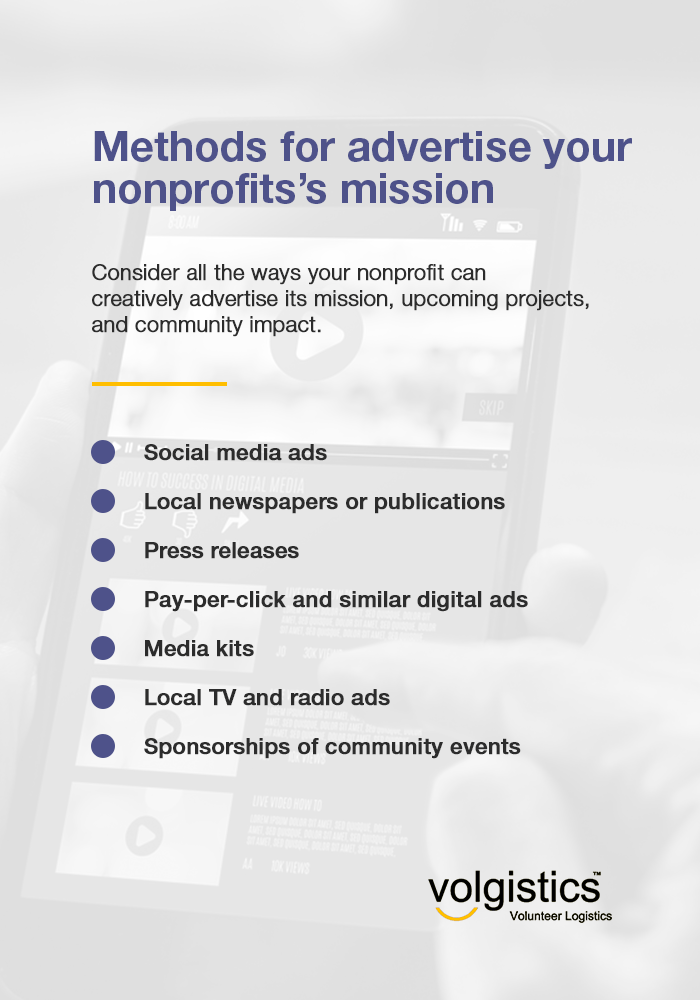
Even small nonprofits with limited budgets have a buffet of cost-conscious marketing and advertising options to get their names in front of prospective donors. Best of all, these methods are scalable, ready for redeployment every month, quarter, or year to broadcast your new priorities.
Consider all the ways your nonprofit can creatively advertise its mission, upcoming projects, and community impact.
- Social media ads — Facebook, Twitter, Instagram, LinkedIn, etc.
- Notices in local newspapers or regional publications, published via discounted or waived fees for nonprofits
- Press releases
- Pay-per-click and similar digital ads
- Media kits
- Local TV and radio ads
- Sponsorships of community events, teams, etc.
6. Offer Donation Matching
Gift matching is a powerful way to optimize the not-for-profit fundraising donor pools you’ve already established. These programs work particularly well as a corporate fundraising strategy, where area businesses promise to match private donations dollar for dollar.
Get creative with your donation matching setup. Have volunteers approach their employees with the fundraiser and its incentive. Post a gift-matching portal on your website and social media. Ask area influencers to be brand ambassadors for your fundraiser. All these strategies, and more, wield a significant compounding effect on your funds raised.
7. Reach out to Value-Aligned Businesses
Area businesses provide an intuitive partner for collaborative fundraising. For example, reach out to local restaurants or coffee shops to set up days throughout the year where a portion of proceeds goes to your nonprofit. On your end, you create a set of multimedia advertisements and merchandise with that restaurant’s logo and information, offering ongoing advertising.
Ensure your partnership pitches are clear, value-additive, and persuasive. Include exactly where proceeds will go, either for your operations or back out into the community, then shout your thanks with a donor thank-you personalized for that organization.
8. Recognize All Donors

Donor recognition strategies include both formal and informal ways of broadcasting your thanks to those who’ve participated in your fundraising. From handwritten thank-you notes to social media shout-outs to catered meals or recognition dinners, these moments are crucial to donor retention — as well as treating these valuable individuals as real people.
Remember to temperature-check a donor’s comfort levels or thank-you preferences. Not everyone receives praise the same, or will even be comfortable with public recognition such as a thank-you post on Facebook. Consider adding a field to donor forms where you list any public thank-you methods, letting the individual authorize consent to having their name shared.
9. Find What’s Most Profitable
Private businesses take great care to track every marketing and engagement tactic they’ve employed. Nonprofits benefit significantly from the same mindset, creating and then tracking target goals for nonprofit fundraising event ideas undertaken across the year.
For example, in one year, your organization might conduct its annual holiday drive, sell T-shirts, offer a 50/50 raffle, partner with a restaurant for proceeds, launch one large themed crowdfunding campaign, and host a handful of ticketed micro-events with proceeds going toward your operations. There are a variety of crowdfunding platforms for nonprofits you can choose from. Keep track of which of these events draws the most donations and the most public enthusiasm, then scale them for next year.
It’s crucial for nonprofits also to be sensible about fundraising activities for volunteer organizations. As the 80/20 rule reminds us, 80% of the fundraising events and tactics you try will likely turn out tepid, while 20% of fundraising efforts will generate genuine donation results. You can’t optimize that 20% if you aren’t keeping track.
10. Accept Tips and Donations
One of the most straightforward donation ideas for a fundraiser is to consider adding a digital “tip jar” to your nonprofit’s website. These buttons, housed on a handful of key donation pages, elicit small donations of anywhere from $1 to $25, with visitors able to give small, one-time gifts straightforwardly.
Better yet, social media apps like Facebook have even launched special fundraising toolkits designed to help nonprofits support donation portals right on their profiles. Visitors don’t even have to be on your website to give financial support — they donate right there on your page.
11. Connect with Donors on Social Media
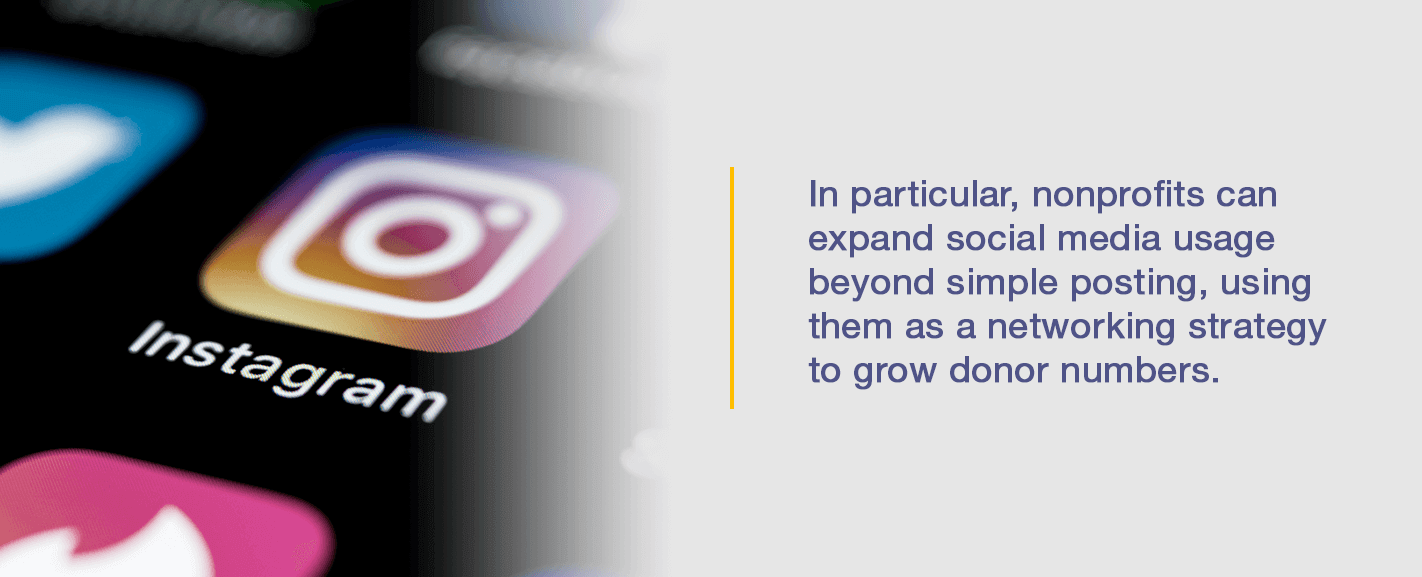
Social media platforms offer one of the most dynamic charity fundraising ideas aimed directly at new and prospective supporters alike. In particular, nonprofits can — and should — expand social media usage beyond simple posting, using them as a networking strategy to grow donor numbers.
Leveraging social media to grow your network provides two key fundraising benefits. First, it improves your name brand as a philanthropic outfit in the community. Second, it gives you a more significant potential donor pool to connect with. Use the networking function of social media to:
- Join relevant industry or philanthropic groups on Facebook, etc.
- Launch peer-to-peer fundraising campaigns
- Appoint brand ambassadors from current staff and volunteers
- Partner with on-brand social media influencers
- Foster creative user-generated content
12. Engage Multiple Donor Personas
Many nonprofits get stuck playing ping-pong between prioritizing high-value, big-ticket donations, and incremental, everyday contributions. Both tiers are essential to effective fundraising for nonprofits, and both types of donors require personalized engagement strategies with tailored marketing materials.
If you haven’t already, formally draft your nonprofit’s current key donor personas. These are a sketch of the types of people most likely to engage and support your causes, characterized by donor history as well as lifestyle, likes, interests, and activities. Donations from each persona serve a different purpose. For example, your highest-net-worth personas support internal sustainability, as well as project impact or facility expansion. Mid- and low-net-worth personas contribute to campaign-specific goals and everyday operations. Both are pivotal to your survival, and both require different engagement collateral.
13. Be a Community Fixture
Nonprofits are one of the few remaining majority-trusted institutions for the average American, ranking far ahead of others like big businesses, banks, and newspapers. While charitable sector trust has wavered in recent years due to growing concerns over donor transparency, the majority of Americans still look favorably on nonprofits — particularly local ones.
One of the best ways for organizations to nurture trust and improve fundraising strategies is to integrate fully into their surrounding communities. Nonprofits should seek every opportunity to interface organically with real people in their areas. Think stalls at farmers’ markets, festivals, and fairs, participation in holiday parades, or handing out free snacks or merchandise at concerts in the park. The more your nonprofit cultivates positive community PR, the wider your network and the more natural your donor engagement strategies.
14. Launch Text-to-Give Campaigns
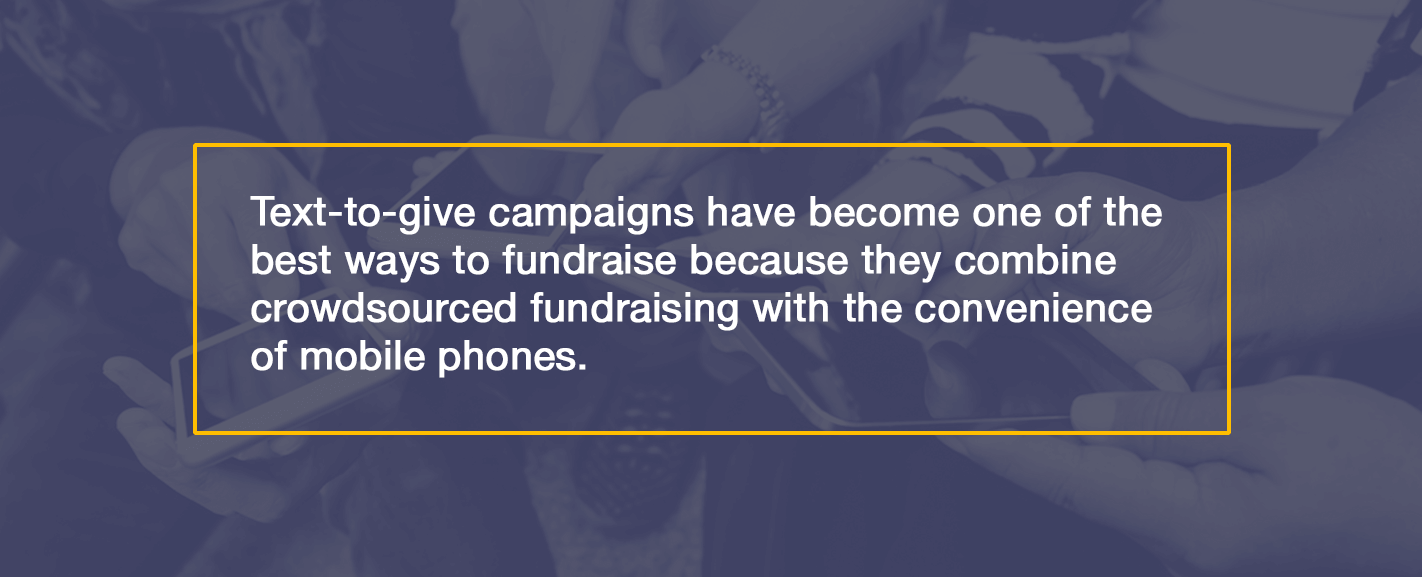
Text-to-give campaigns have become one of the best ways to fundraise because they combine crowdsourced fundraising with the convenience of mobile phones. They’re a savvy, contemporary way to drum up attention for a specific cause, as well as attract large groups of new donors, particularly among younger generations and volunteers.
Better yet, this donation strategy isn’t location-contingent. Donors can contribute to your cause from anywhere, at any time, compared to traditional in-person fundraisers requiring advanced event awareness, access to transportation, and a cleared calendar.
15. Host Cook-Offs (and Other Upbeat, Budget-Conscious Events)
Looking for unique, yet approachable, team fundraising ideas for nonprofit organizations, those you can easily fold into a current philanthropic calendar? Consider cook-offs, a fun, taste-buds-approved way to bring together supporters for a good cause.
If you’re organizing one of these types of fundraising events for nonprofits, have participants sign up to prepare a dish ahead of time. During the event, guests vote on their favorite dishes, with winners earning a special prize. Cook-offs are an excellent venue to host simultaneous small fundraiser ideas as well, such as a silent auction or a 50/50 raffle. For bonus points, you can tack text-to-give campaigns on top of the event, too, further compounding donations.
16. Fundraise Often to Stay Top Of Mind
A successful donor engagement strategy doesn’t begin and end with a donations appeal. It publishes content and sends communications such as emails and texts year-round, often without appealing for any direct contribution.

Nonprofits must seek ways to stay in donors’ minds and hearts without making them feel like piggybanks. Contacting supporters only when you need money is the surest way to sour their impressions of you — and dissuade them from donating ever again.
Nonprofit Fundraising Best Practices and Tips
Once you’ve considered the group fundraising ideas listed above, you may now be looking for ways to strengthen the overall management and execution of your fundraisers. You’re not alone. Managing ongoing, streamlined fundraising operations is one of the top pain points for nonprofit managers and directors. Tackle fundraising and donations management head-on with these industry best practices.
1. Clarify Your Case for Support
Cases for support are the fundraising “elevator pitches” for your nonprofit’s major projects and initiatives. In them, you outline what your organization will accomplish with a donation, as well as the broader impact of that project or initiative in the community.
Review your case for support first for clarity, then for vision. Often, the language found here will be one of the earliest donation pitches a target supporter receives. Plus, you will reiterate cases on your website and online donation forms. You want to ensure your ask is unmistakable, its impact worthy, and its purpose meaningful.
2. Review Your Donor Management Data System
Donor management data systems streamline many of the activities involved in front- and back-end donor relations. From managing contact information and event attendance to triggering serialized marketing campaigns, personalized communications, and logging engagement, these programs help your nonprofit perform donor engagement bigger and better.
At a minimum, your donor management system should organize touchpoints and donor history. At their most successful, programs can mirror customer relationship management and volunteer management software, maximizing your relationships with donor rolls.
3. Engage Donors Online

Today, online fundraising for nonprofits both amplifies as well as complements traditional, in-person fundraising events. Online donation pages provide an evergreen portal offering donation tiers and customized totals. Social media toolkits let followers donate and share directly with a few simple clicks. Text-to-give drives and online auctions expand contribution totals — and are often cheaper to host than their in-person equivalents. In short, if you’re not online, you’re not maximizing your fundraising goals.
4. Identify In-Kind Opportunities
Successful nonprofit fundraising seeks to maximize revenue through solicited and organic donations. Yet donated dollars go furthest when they land in the laps of streamlined, efficient operations — in other words, nonprofits with sustainable, lean operations performed under a manageable budget.
In-kind donations and volunteer work are a fantastic strategy to reduce specific administrative and operational costs. Skilled volunteers perform a monumental amount of cost-saving services, from bookkeeping and tax filing to website development, social media growth, event planning, grant writing, event entertainment, and legal assistance. Businesses can also donate equipment, software, rental or venue space, event catering, and more at free or discounted rates.
In this sense, being top of your game at fundraising also means finding ways to stretch current dollars as far as they can go.
5. Master Marketing Basics
Your organization may not be for-profit, but it must market itself as one. Employing modern marketing practices helps put you in the driver’s seat, owning your brand reputation and donor familiarity. Benefactors across all generations are more likely to give to charities they’ve heard of, ones with positive reputations and established causes. Mastering core marketing practices, particularly digital ones like the following, ensures you’re respected and on the radar, and therefore more likely to solicit donations. Consider:
- Websites crafted for SEO
- Mobile responsive pages
- Multimedia content on social media, in newsletters, and within your website
- Active social media accounts
- Authoritative, industry-relevant blog posts
- Quick responses to calls, emails, and social media messages
Why Nonprofit Fundraising Is So Valuable
The National Center for Charitable Statistics reports charitable donations from businesses, foundations, and individuals reached record highs of over $410 billion in its last national report. The vast majority of those private givings go toward supporting a nonprofit’s operational costs, following by individual impact initiatives.
You don’t need another reminder of how valuable those private donations are for your nonprofit. On par with these national figures, private donations make up over half of small- to medium-sized nonprofits’ annual budgets, which have expenses between $50,000 and 500,000. Without private fundraising, organizations couldn’t do what they do — or continue existing. With them, they become well-oiled philanthropic machines experiencing more than just a financial boost.
1. Sets You Apart
Fundraising initiatives offer one of the strongest ways to identify your nonprofits from others in the sector. From formal cases for support to tiered donation language, from the ads you launch on Facebook to the posts you publish daily, fundraising promotes who you are and what you’re about. In simpler terms, it’s your differentiator — one you want to shout from the rooftops.
2. Primed for Your Needs and Goals
Fundraising strategies are diverse and multifaceted. Tactics will differ between small and large nonprofits, as will the aims of their final contributions and the reasonable impact an organization can make.
At smaller nonprofits — categorized as those with annual expenses between $50,000 and $500,000 — private donations often funnel into one or two major initiatives drawn out over the year, as well as support the organization’s major operating costs. Charitable growth provides these smaller nonprofits a means to break from the donation-by-donation mode of operations, building a more sustainable business model gradually.
For large organizations, fundraising goals and methods often define its culture and help assess larger operational inconsistencies or blind spots. Its institutionalized fundraising resources have integrated donation procurement into the business model itself. As a result, larger nonprofits can take on more projects dedicated to a wider range of causes without overburdening current donor rolls or stretching themselves too thin.
3. Builds Relationships
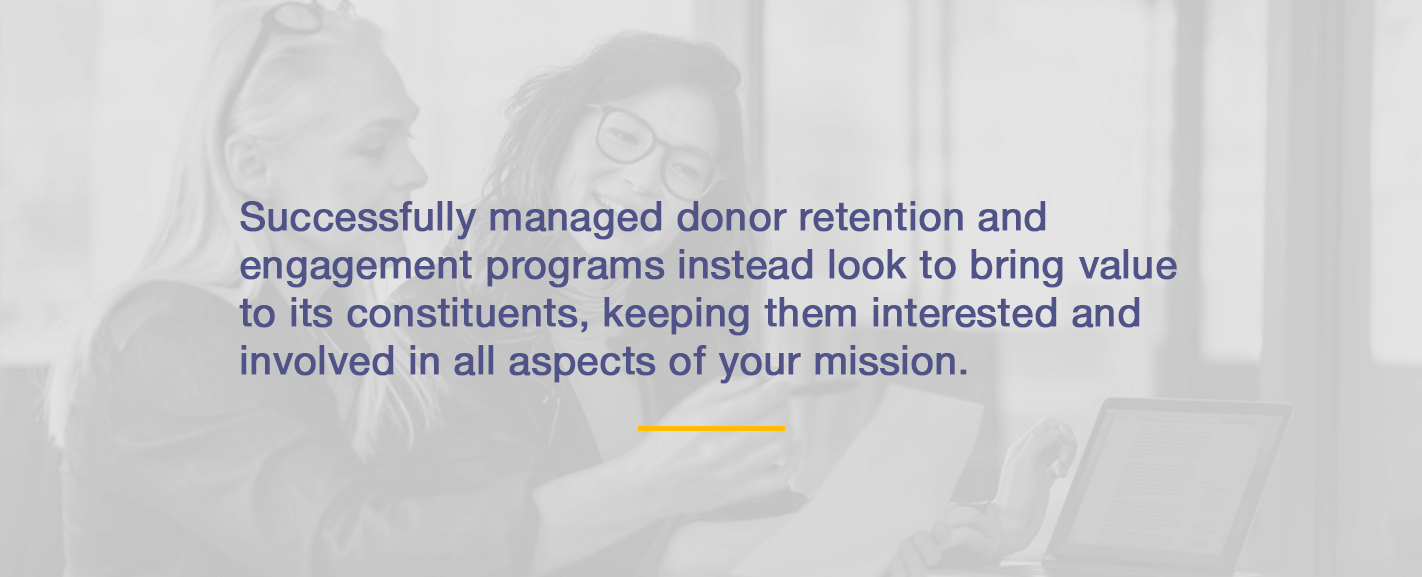
The most innovative donor management strategies center the donor-nonprofit relationship, not the money. As mentioned earlier, treating donors like piggybanks and nothing else is the quickest way to burn bridges. Successfully managed donor retention and engagement programs instead look to bring value to its constituents, keeping them interested and involved in all aspects of your mission. You should only begin donation solicitation after establishing a true, meaningful, and organic relationship.
4. Defines Your Brand
At its best, your brand exudes a powerful, authentic purpose represented in all your nonprofit’s internal and external activities. The public innately trusts the work you do, plus how you do it, and views donating to your causes as their way to participate in a greater good.
No other institution strikes quite the same do-good, feel-good balance as charitable nonprofits. When your organization fine-tunes its donor management best practices, it, too, joins the ranks to be an elite cultural force contributing to objective social good.
5. It’s Not Going Anywhere
Let’s face it: Nonprofit fundraising is here to stay. It’s one of the most pivotal channels of revenue for philanthropic organizations today, without many indicators for wide-scale social or structural reform reshaping how nonprofits support themselves.
Learning to navigate the donor engagement waters successfully steers your organization toward sustainability. It ensures you’re doing everything in your power today to prepare — and then grow — tomorrow, living out your truest mission.
Experience Easier, Improved Nonprofit Management Today

Effective fundraising strategies empower your volunteer organization to fulfill its mission, and so does volunteer management software from Volgistics. Start your free trial with Volgistics’ volunteer management platform, or get in touch to ask about specific product features, pricing, and more.

